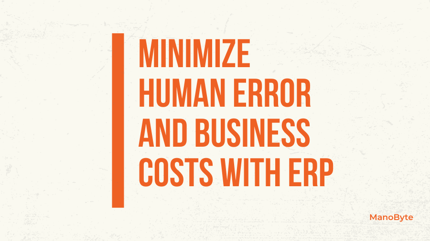Minimize Human Errors and Business Costs with ERP
Chelsea Carter

Humans make mistakes. It's just a fact of life. Whether a salesperson entered the wrong order number and the warehouse shipped a product that a customer didn’t request, or an employee unknowingly sent a malicious attachment to coworkers, human error can have significant business impacts. Many of these human errors can be avoided when having the appropriate systems and risk management policies in place.
Understanding the types of human errors that are more prone to occur in operations and rectifying these issues can help your business avoid profit losses. Learn more about the human errors that can occur in your business and how an ERP system can automate repetitive tasks to make operations more efficient.
Common Human Errors in the Workplace
Most human errors fall into the following categories: lapses in memory, a slip, knowledge-based mistakes, and rule-based mistakes.
- Lapses: A lapse occurs when an employee may forget to perform a specific action, step, or procedure
- Slips: This issue occurs when an employee may perform the wrong action or incorrectly read or interpret information
- Knowledge-based mistakes: Knowledge-based mistakes happen when an employee may lack experience, or apply the wrong logic, when performing an action if there are no standardized business rules to follow
- Rule-based mistakes: Rule-based mistakes may consist of an employee following a bad business rule that creates an error, or a good rule is in place but is not applied in the right manner
Lapse Errors
Common lapse errors can range in severity, from simple, forgetful mistakes to issues that can leave your company vulnerable to cybersecurity hacks. These errors can occur because an employee was so busy that they forgot to perform an important step in their work, or they forgot to include everyone in important communication that would benefit the team project. Another type of human error involves the employee forgetting to update records or reports with the correct information.
Slip Errors
An example of this common human error may be that an employee is performing so many manual tasks that they may inadvertently make a mistake while trying to keep up. They might key in information into the wrong document while trying to rush to complete the task, or have an accidental finger slip and tap on the wrong number key. These errors often have a domino effect through the company as each department using the same information or analysis make their own inadvertent errors in their work.
Knowledge-Based Mistakes
A common knowledge-based human error involves an employee left to their own devices and faced with a problem they don’t have an answer to. They may be unable to communicate with other members of the project team. or may be working with incomplete data. Unfortunately, if there are no set company rules in place that provide details on how to address their issue, they may rely on their limited knowledge and resources to take a course of action that is not appropriate.
Rule-Based Mistakes
Some rule-based mistakes happen when working with legacy systems and software, or when a business changes ownership. Old rules may be in place that are not appropriate with the current operations of the company, leaving employees to continue following the previous rules to complete their daily tasks. In another example, there might actually be a good rule in place, yet the rule can be interpreted in different ways based on the employee, the task at hand, or within the department. These different interpretations can lead to human errors.
How ERP Implementation Reduces Human Errors
Enterprise Resource Planning (ERP) systems can be leveraged to reduce many of the lapses, slips, rule-based mistakes and knowledge-based mistakes that occur in the work environment. With a company-wide ERP system installed, data can be shared and updated in real-time. Many manual tasks are automated as the system also helps to boost collaboration between employees. Some ways that ERP can help reduce human errors include:
Data Consolidation
When data is spread out over different systems and networks that have no way to communicate with each other, redundancy and errors can occur. It is difficult to continuously have workers update the same file over and over again for each network system, as there could be several versions of the same file with differing information. Instead, ERP places all the data into one centralized system that can be accessed across the company. When the data is updated in real-time, employees get the information they need to be more proactive and productive with their work. In addition, accountability is now in play as any modifications can be tracked and monitored.
Communication Enhancement
ERP's interactive features and tools allow for more effortless communication within the company and among project teams, so no one is left out of the loop. Employees can easily access the information that is most pertinent for their tasks, which helps to reduce knowledge-based mistakes. In addition, employees and managers have more control when updating business rules or rectifying issues. They can inform the entire workforce of these changes to reduce rule-based mistakes.
Manual Task Automation
Manual tasks that are repetitive can be eliminated with the automated features offered through a successful ERP implementation. This strategy can reduce imputing errors as employees can focus their time on more productive tasks to please your customers. This automation can apply to many different departments in the company, including sales, accounting, and warehousing.
We Are Here to Help with ERP Implementation
If you are looking for a way to reduce business costs and disruptions that are associated with human errors, an ERP system may be the right solution. Let Manobyte help your company with the implementation process. Our digital and cloud solutions are tailored to your operations so you can fully leverage this system. Talk to one of our team members today.
Ready to Dive In?
Work with our team of Business Process experts and watch us take manual clunky systems, tech stacks, and processes and turn them into tailored, intelligent workflows that deliver business outcomes.




